April 8, 2017 show
Italians during WWII and Camp Atterbury history
Amid the interest sparked by the Indiana Historical Society's new "You Are There" exhibit of a chapel built by Italian prisoners of war at Camp Atterbury, Hoosier History Live will take the opportunity to explore interrelated chapters of our heritage.
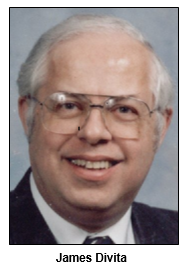 We will look at life during World War II for Italian families across Indiana. Did they confront discrimination? Where did they live in the Hoosier state? Were they aware of the 3,000 Italian prisoners of war who were held at Camp Atterbury, most of them after being captured in North Africa? We will look at life during World War II for Italian families across Indiana. Did they confront discrimination? Where did they live in the Hoosier state? Were they aware of the 3,000 Italian prisoners of war who were held at Camp Atterbury, most of them after being captured in North Africa?
We also will explore the unfolding of Camp Atterbury, which was planned just before the U.S. entry into WWII. Today, the camp, primarily located in Johnson County, is the state's largest military installation. It is operated by the Indiana National Guard.
Nelson will be joined in studio by three guests:
- Dr. James Divita, past president of the Italian Heritage Society of Indiana and professor emeritus of history at Marian University. Dr. Divita is the author of Indianapolis Italians (Arcadia Publishing, 2006) and of the chapter about Italians in Peopling Indiana (Indiana Historical Society Press, 1996).
- Master Sgt. Bradley Staggs, public affairs officer at Camp Atterbury. Italian POWs arrived there in 1943; many worked under supervision at local farms within a 25-mile radius of the camp. After Italian POWs left in 1944, German POWs were held at Camp Atterbury.
 And Angela Wolfgram, a historical researcher for the Indiana Historical Society. The society's exhibit is a replica of a chapel that the Italian POWs were permitted to build using cast-off material. The chapel's altar was created so that it resembles marble.
And Angela Wolfgram, a historical researcher for the Indiana Historical Society. The society's exhibit is a replica of a chapel that the Italian POWs were permitted to build using cast-off material. The chapel's altar was created so that it resembles marble.
The actual chapel still stands in a meadow at Camp Atterbury. Unused after the war except for storage, the POW chapel had deteriorated alarmingly until it was restored about 27 years ago as the result of a project that involved the Italian Heritage Society.
Today, Italian immigrants and their descendants account for about 3 percent of the state's population, according to the heritage society. Indiana cities with the highest percentages of Italian heritage residents include Clinton, Dyer, Crown Point, Cedar Lake and Munster, according to statistics supplied by Dr. Divita.
Some history facts:
- During the Revolutionary War, Italian fur trader Francis Vigo (namesake of Vigo County) financially supported George Rogers Clark's forces in their successful capture of the fort in Vincennes from the British.
- During World War I, Italy sided with the Allies. The country later suffered from a weak post-war economy.
- Hoosier History Live explored the immigration of Italian marble-cutters to southern Indiana to work as limestone cutters during a show in May 2010.
- No Italian POW ever attempted to escape from Camp Atterbury during World War II.
 At the height of the wars in Iraq and Afghanistan, thousands of troops and civilians moved through Camp Atterbury, according to news accounts. In recent years, the camp has diversified its mission by hosting anti-terrorism exercises and cybersecurity training. At the height of the wars in Iraq and Afghanistan, thousands of troops and civilians moved through Camp Atterbury, according to news accounts. In recent years, the camp has diversified its mission by hosting anti-terrorism exercises and cybersecurity training.
The chapel at Camp Atterbury built by the Italian POWs is sometimes called the "Chapel in the Meadow;" it is the only remaining structure at the camp directly connected to its prisoners-of-war chapter.
According to the Italian Heritage Society, some of the Italian POWs "were skilled artisans, trained in the use of wood, stone, masonry and painting." The chapel has religious artwork, including frescoes, and a floor painted red to resemble carpeting. A chaplain at the camp who spoke Italian celebrated Mass with the POWs.
According to Indianapolis Italians by our guest Dr. Divita, Holy Rosary Catholic Church on the south side of the Hoosier capital "had an Italian-speaking priest available until the late 1970s." Built between 1911 and 1925, Holy Rosary became the hub of the city's Italian community and is the setting of an annual Italian Street Festival.
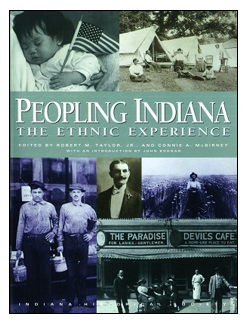 Clinton, the town in western Indiana, also hosts a popular Italian festival. According to Peopling Indiana, Italians immigrated to Clinton and other nearby towns during the late 1800s and early 1900s because of the coal-mining jobs in the region. Clinton, the town in western Indiana, also hosts a popular Italian festival. According to Peopling Indiana, Italians immigrated to Clinton and other nearby towns during the late 1800s and early 1900s because of the coal-mining jobs in the region.
In Indianapolis, generations of Italian families dominated the city's produce industry: "Of the 54 fruit and vegetable dealers operating in 1910, 33 were Italian," Peopling Indiana notes.
As the U.S. moved toward entry in World War II, some Italian clubs in Indiana took care to donate to American charities, as well as to those in Italy, according to Peopling Indiana. Although many of the POWs arrived at Camp Atterbury not knowing English, some of them remained in Indiana after the war, married and raised families.
Some of their descendants have visited the chapel, as well as the "You Are There" exhibit.
History Mystery
Identical twin brothers born in Italy in 1940 had a significant impact on Indiana as adults. Before World War II, generations of the Andretti family were prosperous wine exporters and owned thousands of acres of farmland in northern Italy. When Mario Andretti and his twin brother were young children, though, Nazi soldiers commandeered a hotel in Italy owned by their grandparents.
 The Andrettis lost their land and, after the war, lived in a resettlement camp. When the twins were 15 years old, the family immigrated to the United States. The twins became race drivers. Mario Andretti won the 1969 Indianapolis 500, Formula One races, and even NASCAR's Daytona 500, becoming one of the world's best-known race drivers. He has been based out of Nazareth, Pa., for most of his adult life. The Andrettis lost their land and, after the war, lived in a resettlement camp. When the twins were 15 years old, the family immigrated to the United States. The twins became race drivers. Mario Andretti won the 1969 Indianapolis 500, Formula One races, and even NASCAR's Daytona 500, becoming one of the world's best-known race drivers. He has been based out of Nazareth, Pa., for most of his adult life.
His twin brother - despite earning praise as a young driver - quit racing after a series of serious accidents. He settled in the Indianapolis area and ran successful businesses in the auto industry for more than 40 years.
Question: What is the name of Mario Andretti's twin brother?
The call-in number is (317) 788-3314. Please do not call in to the show until you hear Nelson pose the question on the air, and please do not try to win the prize if you have won any other prize on WICR during the last two months. You must be willing to give your name and address to our engineer and be willing to be placed on the air, and you must answer the question on the air.
The prize is a pair of passes to the Indiana History Center to see "You Are There 1943: Italian POWs at Camp Atterbury," courtesy of the Indiana History Society, and two tickets to ComedySportz, courtesy of Visit Indy.
Roadtrip: Disc golf in rustic Brown County
Guest Roadtripper Rachel Hill Ponko of the Indiana Historical Society tells us that an old golf course in Brown County has been "repurposed" by a local family of five siblings as a 24-hole disc golf course and event center. (Players of disc golf throw a flying disc and try to hit targets, or "holes," with the fewest tosses.)
The Brown County Country Club, or simply BC3, is just three miles from downtown Nashville. The 100-acre property has gone through several transformations in the last century. A 1940s-era farmhouse and orchard was turned into a clubhouse and golf course in the early 1960s. Visitors can play a 24-hole disc golf course, which weaves in and around mowed fairways, forests, hills and ponds. Almost every shot includes an element of adventure, and there is no shortage of wildlife.
"I'm told there is also a 9-hole course that's perfect for beginners like me, but I was content to relax in the natural beauty of this newfound gem," says Rachel. "As an owner of a 130-year-old home," she added, "I could also appreciate all the family has done to update the 1940s-era farmhouse as a clubhouse."
Your Hoosier History Live team,
Nelson Price, host and creative director
Molly Head, producer, (317)
927-9101
Richard Sullivan, webmaster and tech director
Pam Fraizer, graphic designer
Garry Chilluffo, media+development director
Michael Armbruster, newsletter editor
www.hoosierhistorylive.org

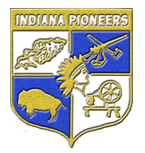  
 

Please tell our sponsors that you appreciate their support: | Indiana Historical Society | Indiana Landmarks | Lucas Oil | MBP Catering | Story Inn | English Ivy's | Indiana Pioneers
  Acknowledgments to Monomedia, Visit Indy, WICR-FM, Fraizer Designs, Heritage Photo & Research Services, Derrick Lowhorn and many other individuals and organizations. We are an independently produced program and are self-supporting through organizational sponsorships and individual contributions. We do not receive any government funding. Visit our website to learn how you can support us financially. Also, see our Twitter feed and our Facebook page for regular updates. Acknowledgments to Monomedia, Visit Indy, WICR-FM, Fraizer Designs, Heritage Photo & Research Services, Derrick Lowhorn and many other individuals and organizations. We are an independently produced program and are self-supporting through organizational sponsorships and individual contributions. We do not receive any government funding. Visit our website to learn how you can support us financially. Also, see our Twitter feed and our Facebook page for regular updates.
Thank you!

Your donation helps keep Hoosier History Live on the air, on the web and in your inbox!
|
April 15, 2017 show - upcoming
Next week, Hoosier History Live will present two 30-minute encore shows from our rich audio archives, each of which focuses on opposing sides of Indiana history. While the clashing subject matter may be jarring, we hope that the juxtaposition helps shed light on both of these important aspects of the Hoosier past.
African-American newspapers across Indiana
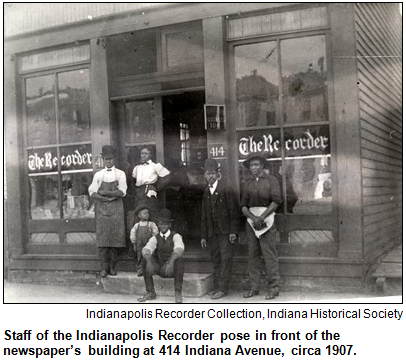 (Originally aired on Feb. 11, 2012) - They covered news, topics and public figures ignored or given short shrift by mainstream newspapers, including the triumphs of athletes such as bicyclist Major Taylor and baseball great Oscar Charleston. (Originally aired on Feb. 11, 2012) - They covered news, topics and public figures ignored or given short shrift by mainstream newspapers, including the triumphs of athletes such as bicyclist Major Taylor and baseball great Oscar Charleston.
Since the late 1800s, African-American newspapers have had an impact on communities across the Hoosier state. The most enduring has been the Indianapolis Recorder, which our guest Wilma Moore calls "the single most important tool for researching the history of African Americans in Indianapolis."
Nelson is joined in studio by Wilma, the senior archivist for African-American history at the Indiana Historical Society.
 In addition to delving into the history of the Recorder, a weekly newspaper that began in the 1890s, we explore the Gary INFO in Lake County; the Evansville Argus, which was published from 1938 to 1943, and the Indianapolis Freeman, a competitor to the Recorder during the 1920s. The Freeman was heralded for increasing the popularity of Negro League Baseball because its sportswriters provided extensive coverage. In addition to delving into the history of the Recorder, a weekly newspaper that began in the 1890s, we explore the Gary INFO in Lake County; the Evansville Argus, which was published from 1938 to 1943, and the Indianapolis Freeman, a competitor to the Recorder during the 1920s. The Freeman was heralded for increasing the popularity of Negro League Baseball because its sportswriters provided extensive coverage.
Known for emphasizing local and statewide news, the Recorder covered topics ranging from the political power of the Ku Klux Klan in Indiana during the 1920s to the jazz scene that flourished along Indiana Avenue in Indianapolis after World War II.
Launched as a two-page church bulletin and business directory in 1897, the Recorder became a weekly two years later. At the turn of the last century, the Recorder reported the triumphs of Indy native Marshall "Major" Taylor, who became a world champion bicyclist.
And in 1901, according to Wilma's research, the Recorder published the names of black Indianapolis residents whose wealth was estimated at more than $5,000. The Recorder also listed African-Americans doing business in Indiana.
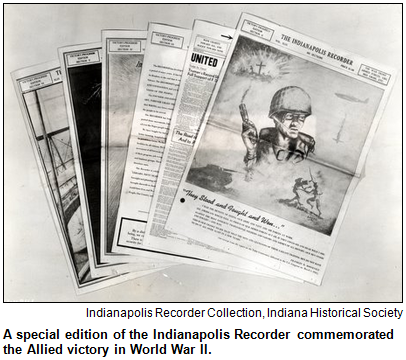 In Evansville, several newspapers serving the black community were launched, with the first appearing in 1880. All of them lasted less than a year, though, until the Evansville Argus began in 1938. Crusading against segregation, the Argus supported efforts to integrate Mechanical Arts, a vocational high school in Evansville. The Argus also published stories about local and national accomplishments by African-Americans. In Evansville, several newspapers serving the black community were launched, with the first appearing in 1880. All of them lasted less than a year, though, until the Evansville Argus began in 1938. Crusading against segregation, the Argus supported efforts to integrate Mechanical Arts, a vocational high school in Evansville. The Argus also published stories about local and national accomplishments by African-Americans.
So did the Indianapolis Freeman, which began in 1888.
Sportswriters at the Freeman were hailed for their in-depth coverage of Negro League Baseball, which, as we noted during a Hoosier History Live show in 2011, held their first official game in Indianapolis.
The Freeman extensively covered the triumphs of Indy native Oscar Charleston (1896-1954), a star in the Negro leagues who is considered to have been one of the greatest (albeit generally unheralded) players in baseball history.
In general, though, the Recorder offered much more extensive local coverage than the Freeman. That, according to the Encyclopedia of Indianapolis, was one of the factors in the demise of the Freeman in 1926.
Two newspapers also served the African-American community in Gary during more recent times. The Gary INFO stopped publishing in the late 1990s, according to Wilma's research. The Gary Crusader is affiliated with the Chicago Crusader; the publications even have shared some editors.
The Recorder, though, has the distinction of being the state's longest continually operated African-American newspaper. 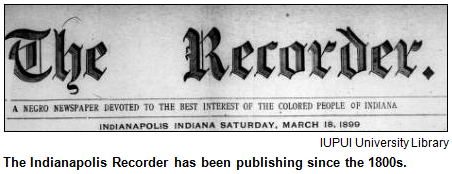 The family of one of its co-founders, George Stewart, owned the newspaper until the late 1980s, when it was purchased by former Indianapolis Star editor Eunice Trotter. In 1990, the weekly was purchased by Indianapolis businessman Bill Mays. Mays died in 2014. The family of one of its co-founders, George Stewart, owned the newspaper until the late 1980s, when it was purchased by former Indianapolis Star editor Eunice Trotter. In 1990, the weekly was purchased by Indianapolis businessman Bill Mays. Mays died in 2014.
Distinguished journalists who began their careers at the Recorder include Washington Post columnist William Raspberry, who was nationally syndicated. Raspberry died in July of 2012.
Since the 1970s and '80s, the Recorder has provided extensive coverage of Indiana Black Expo and the Circle City Classic, two Indianapolis-based events that have drawn national attention.
"It is the single, most important publication that captures a panoramic view of 20th-century black Indianapolis," Wilma has written of the Recorder.
The digital archives of the Recorder are available at IUPUI's University Library. The full-text, searchable archives include more than 5,000 issues of the newspaper.
Editor's note: Wilma Moore retired in February of 2017 from the Indiana Historical Society as Senior Archivist of African American history.Â
Indiana KKK in the 1920s
(Originally aired on April 24, 2010) - 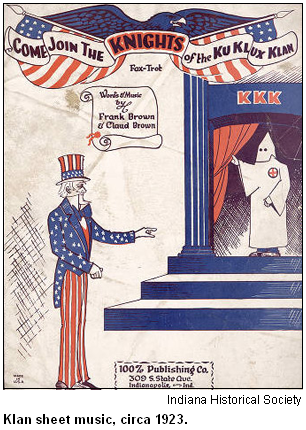 Hoosier History Live is dedicated to covering all aspects of Indiana's past, including those we wish had not happened. Certainly the political and cultural dominance of the notorious Ku Klux Klan during the 1920s falls into the category of shameful. To explore what happened and why, Nelson is joined in studio by Allen Safianow of Kokomo, a professor emeritus at IU-Kokomo who has done extensive research on the KKK in Indiana. Hoosier History Live is dedicated to covering all aspects of Indiana's past, including those we wish had not happened. Certainly the political and cultural dominance of the notorious Ku Klux Klan during the 1920s falls into the category of shameful. To explore what happened and why, Nelson is joined in studio by Allen Safianow of Kokomo, a professor emeritus at IU-Kokomo who has done extensive research on the KKK in Indiana.
The central figure during the 1920s heyday of the hate group was the flamboyant D.C. Stephenson (1891-1966), who rose to become Grand Dragon. Stephenson intimidated Indiana politicians, recruited large numbers of Hoosier members and even boasted, "I am the law in Indiana."
Stephenson's downfall (and the decline of the KKK's dominance in the state) came when he was arrested in the death of an Indianapolis woman whom he had brutally raped.  During a sensational trial in 1925, Stephenson was found guilty of second-degree murder. The trial was in Noblesville, which drew national attention again decades later when a local building contractor discovered Klan records and memorabilia dating back to the 1920s. During a sensational trial in 1925, Stephenson was found guilty of second-degree murder. The trial was in Noblesville, which drew national attention again decades later when a local building contractor discovered Klan records and memorabilia dating back to the 1920s.
Professor Safianow has analyzed the impact of those records, which contained membership rolls of Hamilton County citizens, as well as hoods and sashes.  Professor Safianow also has analyzed the KKK's impact during the 1920s in other parts of the state, including Tipton and Kokomo, said to be the site in 1923 of the largest conclave (called a "Konclave") ever held in the United States. Professor Safianow also has analyzed the KKK's impact during the 1920s in other parts of the state, including Tipton and Kokomo, said to be the site in 1923 of the largest conclave (called a "Konclave") ever held in the United States.
"At its height in the 1920s, one quarter to one third of native-born, white males in Indiana were Klan members," Professor Safianow noted in an article in the Indiana Magazine of History about the discovery of the Hamilton County membership records and memorabilia.  He also notes that the unraveling of - and infighting among - the Klan in Indiana had begun even before Stephenson's trial. In the aftermath, confidential files were released that described corruption and Klan ties to the administration of Gov. Ed Jackson. He also notes that the unraveling of - and infighting among - the Klan in Indiana had begun even before Stephenson's trial. In the aftermath, confidential files were released that described corruption and Klan ties to the administration of Gov. Ed Jackson.
In Indiana, the resurgence of the KKK (which had flourished after the Civil War in the Deep South) is often traced to the arrival in Evansville in 1920 of a Klan recruiter named Joseph Huffington. Agents then began recruiting members in southern Indiana. Stephenson, a Texas native who spent much of his youth in Oklahoma, also drifted to Evansville in the early 1920s, then moved to Indianapolis.
During a 12-month period beginning in July 1922, more than 100,000 Hoosier men joined the Klan, according to some experts. Targets of the KKK during the 1920s in Indiana included immigrants, Catholics, Jews and African-Americans.
Professor Safianow, a New Jersey native educated at Rutgers and Cornell, moved to Indiana in the early 1970s to join the faculty at IU-Kokomo. He says he began his research on the KKK because of Kokomo's connection to the massive rally in 1923, noting the challenges that confront historians who attempt to get a handle on the Klan of the 1920s.
© 2017 Hoosier History Live. All rights reserved.
|